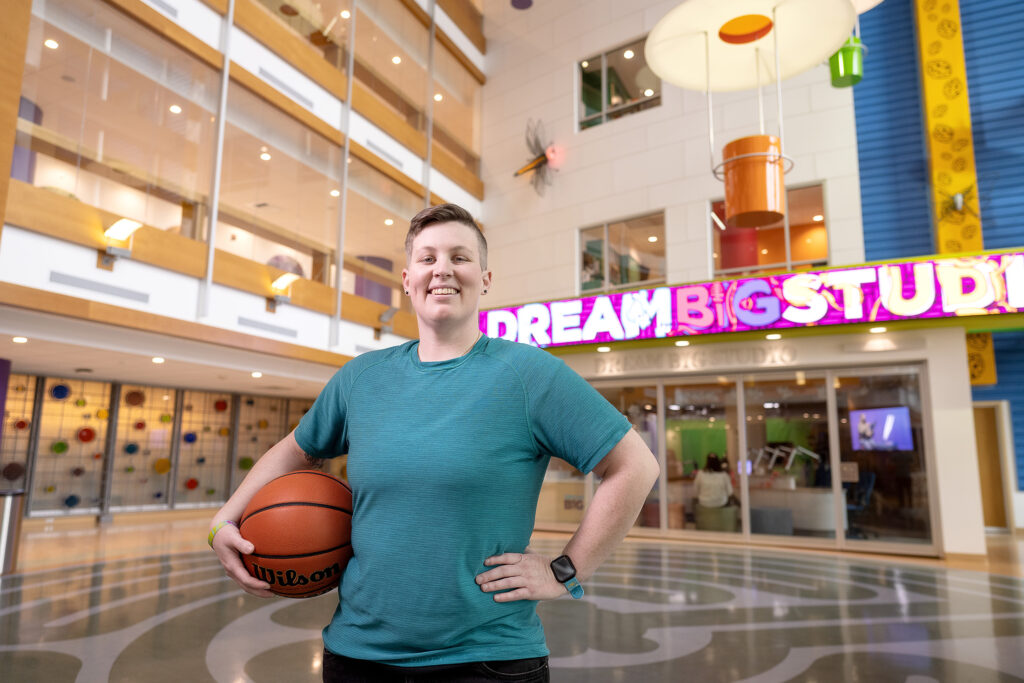Children and adults who live with visible and non-visible disabilities — whether temporary or permanent — face unique challenges that require unique solutions.
The need to undergo rehabilitation can take a physical toll and impact patients’ confidence. This leads them to doubt their abilities or fear exclusion from activities they love. This is why UPMC Children’s has a dedicated recreation therapist. During recreation therapy, Tayler Tadrick, CTRS, uses recreation and other activity-based interventions to help children heal, safely incorporating elements of their favorite leisure activities into their rehabilitation. As patients get physically stronger, they also build confidence that will help them thrive upon discharge.
In her role at UPMC Children’s, Tayler has worked with patients ranging from 9 months to 27 years old. “Everyone can benefit from recreation therapy regardless of their age, physical abilities, or intellectual abilities,” Tayler said. “Everyone has a leisure activity they love. Incorporating these activities into rehab helps people with and without disabilities continue to do what they love, which helps prevent the anxiety and depression that can come with not doing anything at all.”
Therapy Tailored to Each Patient’s Unique Journey
Tayler finds creative ways to utilize leisure activities to help patients meet their rehabilitation goals, often collaborating with physical therapy and occupational therapy in the process. These activities include:
- arts and crafts
- games
- spending time outdoors
- socializing with friends and family
- playing sports
- anything else patients self-identify as an activity which clears their mind and brings them inner fulfillment
“It’s a unique experience for every patient because it depends on what they like to do,” Tayler explained. The 27-year-old heart transplant patient Tayler worked with was a volunteer firefighter, so he identified activities that would help him continue to do that work upon discharge, like lifting weights and working on balance and stability. Tayler also worked with a 14-year-old patient who, after undergoing brain surgery, had to re-learn how to walk and restore her hand-eye coordination. “She loved soccer, so when she was ready, I would roll her the ball and she would stop it with her foot, aim and kick it back to me, and dribble it from side to side,” Tayler said.
Empowering Patients and Families Alike
In addition to working with patients one-on-one in the rehabilitation unit, Tayler facilitates family-led community outings for patients who have been in rehab for more than three weeks and are ready to get back out into the world.
Whether it’s a zoo trip or a basketball game, Tayler said outings are key to helping families realize they are ready to go home and support their child without the help of hospital staff. “Community outings help families feel confident that they can still do fun, fulfilling, everyday activities with their kids who have disabilities. These are totally family-led, and I go with them to empower them and troubleshoot when needed,” Tayler shared. “It allows them to practice things like successfully transferring their child in and out of the car, using accessible transportation like a wheelchair van, and making other adjustments to help the child, the siblings, and the whole family have a great day.”
Central to Tayler’s work is the philosophy that a person’s disability does not make them different from everyone else. “When a person has a disability, they might think, ‘This is it, I’ll never be able to do the things I love again, and I’m always going to be different.’ But that’s not the case at all,” Tayler said. “You might be using a wheelchair when you leave the hospital, but who cares? You’ll still participate in class, go to the gym, play games with friends, all those things. If you love archery, we can adapt your bow. If you love sports, we can get you on a power soccer team or into wheelchair basketball. If you love painting, we can get you an adaptive paintbrush. Your equipment might make you look physically different, but you’re not different.”
The Future of Recreation Therapy
Currently, Tayler is the only recreation therapist at UPMC Children’s, and she works exclusively with patients receiving care in the rehabilitation unit. She is excited to have recently recruited the program’s first-ever intern, and she is hopeful that in the years to come, recreation therapy can expand to serve patients throughout the entire hospital. “My dream is to have a recreation therapist on every single unit,” Tayler said. “Because no matter your age or your diagnosis, you can benefit from it. I don’t want you to sit on the sidelines — everyone deserves to play in the game.”

